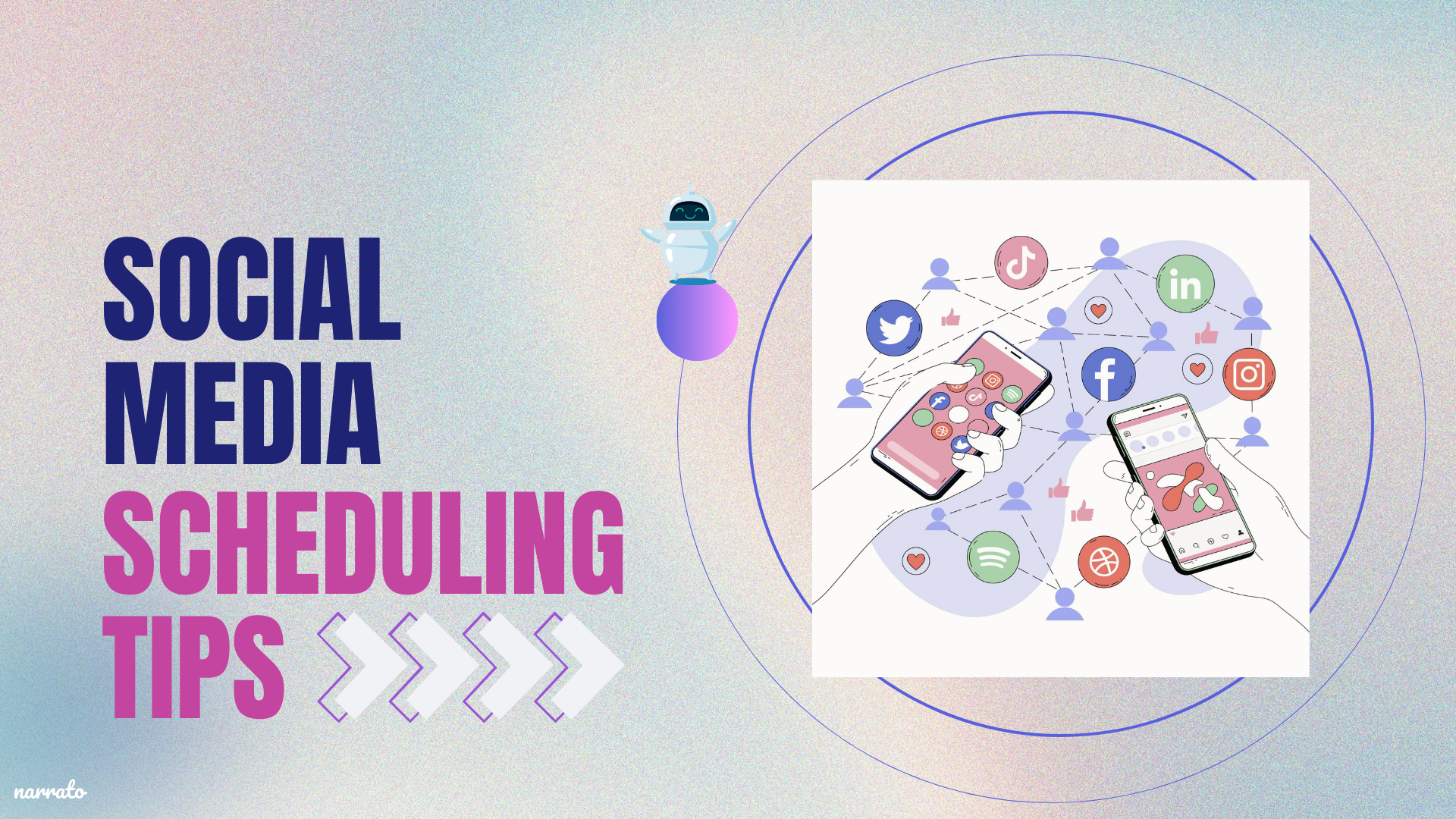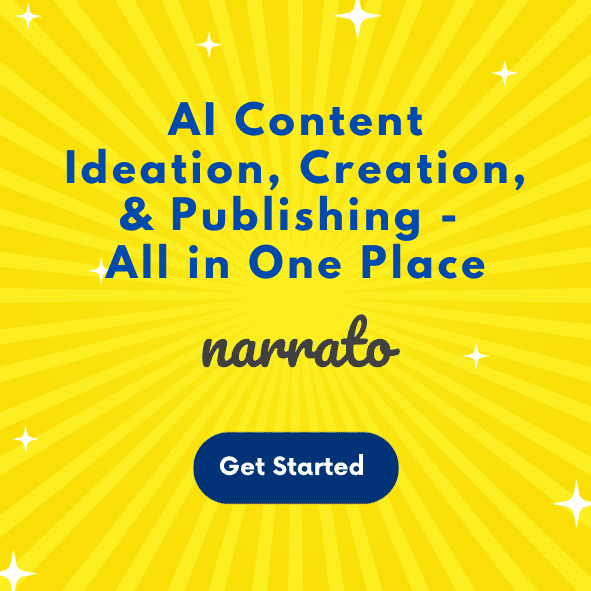Think you can streamline your social media workflow and save even more time? Automating repetitive tasks is a good place to start. Post scheduling, for example. And that’s just one tactic out of many effective ways to manage your social accounts and platforms more efficiently. Check if these social media scheduling tips have escaped your radar and discover how scheduling tools have evolved to make life much easier for social media managers.
Turn your to-do list into a done list
- 1. Plan ahead and create a calendar
- 2. Add in flexibility
- 3. Create content in batches
- 4. Templatize
- 5. Keep evergreen content
- 6. Delegate
- 7. Utilize analytics
- 8. Automate scheduling
Narrato — An AI content and scheduling power

Turn your to-do list into a done list!
As a social media manager, you’re the strategy person, the risk management person, the analytics person, and the public relations person. You’re the collaborator in chief, working with marketing, sales, and customer support to ensure a consistent brand message across all platforms and align social media strategy to business objectives.
Content creation and scheduling is not at the top of your priorities list — it is for your team to manage. Unless you’re a one-person social media team, in which case these social media scheduling tips will be even more crucial as they’ll help you manage your workload efficiently and stay consistent without feeling overwhelmed.
1. Plan ahead and create a calendar
Planning ahead is fundamental to an efficient social media workflow. Start by creating a comprehensive content calendar that maps out at least a month of content. This should include key dates, product launches, seasonal events, and marketing campaigns. Having this bird’s-eye view helps distribute content evenly and maintains posting consistency, which social media algorithms favor. A well-structured calendar also ensures you maintain a balanced mix of content types — promotional posts, educational content, entertainment, and user engagement. Remember to align your content calendar with your broader marketing objectives and key performance indicators (KPIs) to ensure your social media efforts support overall business goals.
Example
Monthly Campaign: “Summer Wellness Series”
Week 1: Healthy Recipes
- Monday: Smoothie bowl recipe + prep video
- Wednesday: Quick lunch ideas infographic
- Friday: Weekend meal prep guide
Week 2: Fitness Tips
- Monday: 10-minute home workout video
- Wednesday: Proper form guide
- Friday: Success story feature
2. Add in flexibility
Building flexibility into your social media strategy is crucial for staying relevant and capitalizing on emerging opportunities. While having a structured content calendar is important, leave room for spontaneity and trending topics. Set aside specific slots in your schedule —typically 20-30% of your posting capacity — for reactive content. This “agility buffer” allows you to participate in trending conversations, respond to current events, or share timely industry news without disrupting your core content plan.
Monitor industry hashtags, follow key influencers, and set up news alerts to catch emerging trends early. Leveraging Influencer marketing metrics, you can assess the effectiveness of these trends in driving engagement and adjust your strategy to stay relevant while maintaining authenticity.
Example
Core Schedule (70% planned)
Tuesday/Thursday: Product features
Monday/Friday: Educational content
Flex Slots (30%)
Wednesday: Open for trending topics
Weekend: Community/UGC content
3. Create content in batches
Batching is a game-changing approach to content creation that significantly boosts productivity and maintains consistency. Instead of creating posts day by day, dedicate specific time blocks to produce content in bulk. For example, spend one morning writing all your captions for the week, another session shooting multiple videos, and another creating graphics. This approach reduces context switching and decision fatigue, leading to more efficient workflow and consistent quality.
When batching, organize your sessions by content type or theme to maintain focus. You can also use this time to create variations of your content for different platforms, adapting the format and tone while maintaining the core message. Batching also allows you to maintain a healthy content buffer, reducing stress and last-minute rushes.
Example
Monthly Photo Shoot Schedule
Morning: Product shots (20 images)
- Lifestyle uses
- Product details
- Unboxing sequence
Afternoon: Team content (15 images)
- Behind-the-scenes
- Team meetings
- Work culture shots
4. Templatize
Creating and maintaining templates is a crucial time-saving strategy for social media management. Develop a comprehensive template system that includes design templates for different post types (announcements, quotes, tips, testimonials) and caption templates with predetermined structures.
Establish a clear style guide that defines your brand’s visual elements, tone of voice, and formatting preferences. Organize these templates in an easily accessible system, along with pre-approved hashtag groups for different content categories. This standardization not only saves time but ensures brand consistency across all posts.
Keep your template library updated with successful post formats and regularly refine them based on performance data. Remember to leave room for creativity within these templates – they should serve as a foundation, not a limitation.
5. Keep evergreen content
Evergreen content acts as a reliable content bank that can be strategically reused and repurposed, saving significant time in content creation and scheduling. Rather than constantly creating new content, you can build a library of timeless pieces that remain relevant and valuable to your audience year-round.
Example
Core Article: “10 Home Office Essentials”
Flexible Elements:
- Update product recommendations seasonally
- Add trending workspace layouts
- Include current technology recommendations
- Refresh with new remote work statistics
Keep a library of these evergreen pieces, categorized by theme and purpose, making it easy to pull and refresh content when needed. When scheduling, you can:
- Rotate these posts regularly
- Update with current statistics or trends
- Add seasonal references
- Mix them with time-sensitive content
- Use them as backup content during busy periods
Another time-saving strategy is to repurpose your existing content (turn a long-form piece into multiple social media posts), adapt content across platforms (YouTube videos for Instagram Reels and TikTok clips), and transform formats (podcasts to LinkedIn tips or quote cards).
Content repurposing using AI is faster. AI understands content context, maintaining consistent messaging across different formats and preserving key information. If you’re an enterprise with a large volume of content assets, the generative AI marketing platform Typeface is ideal for repurposing content at scale. Typeface offers a variety of AI templates designed to refactor your existing content into new formats. Whether you’re working with documents, podcasts, or other media, the platform’s intuitive templates help you create high-quality derivative content while maintaining your brand’s voice and message. These templates streamline the repurposing process, allowing you to efficiently expand your content library from a single original piece.
6. Delegate
Delegation is crucial for managing the day-to-day execution of your social media content. While you should maintain control of strategy and analytics, the time-consuming tasks of content posting and scheduling can be effectively delegated. Train a team member to handle the mechanical aspects of your social media presence – uploading posts, scheduling content, and ensuring everything goes live at optimal times.
Create clear guidelines for your delegate, including:
- Posting schedules and time zones
- Platform-specific formatting requirements
- Caption structures and hashtag groups
- Image sizing and quality standards
- Basic troubleshooting procedures
7. Utilize analytics
Leveraging embedded analytics is crucial for optimizing your social media strategy. Focus on key metrics that align with your business objectives, such as engagement rates, reach, conversion rates, and audience growth. Use platform-specific analytics tools to identify peak engagement times, most successful content types, and audience preferences. Regular analysis helps refine your posting schedule and content strategy based on actual performance data rather than assumptions.
Create a systematic approach to reviewing analytics — weekly for quick adjustments and monthly for broader strategy reviews. Use these insights to inform content creation, posting times, and resource allocation. Remember to look beyond vanity metrics and focus on data that directly impacts your business goals.
8. Automate scheduling
While automation is a powerful tool for social media management, it requires strategic implementation. Use scheduling tools to automate posting times and cross-platform sharing, but maintain authenticity in your social presence. Choose automation tools that align with your specific needs – consider factors like the number of platforms you manage, required features, and budget constraints.
Focus automation on repetitive tasks like scheduling, basic monitoring, and report generation. This frees up valuable time for creative content development and genuine community engagement. Remember that while automation can handle the mechanical aspects of social media management, human touch remains essential for building meaningful connections with your audience. By exploring Zapier competitors, you’ll find other automation platforms that might better suit your budget, integrations, or workflow complexity.
Chances are, you’re already familiar with social media scheduling tools to save time on manual posting. But what if you could not only schedule posts but also speed up content creation? This is possible with social media scheduler Narrato, whose intelligent AI generates social media posts and gives you the option to generate all of your social posts, essentially putting content creation on autopilot.

Narrato – An AI content and scheduling superpower
While you manage your social media management strategy, Narrato can support your team in creating content and maintaining a consistent posting schedule. When you want to increase your social media output, Narrato can speed up content creation or spark new ideas for posts. For example, if you wanted to turn one long-form piece into multiple posts, you can have Narrato create posts on tips, statistics, and quotes.
In the example below, Narrato generated (within seconds) a post encapsulating some statistics from a core article “Content Marketing Statistics from 2024 You Should Know Going Into the New Year“. The AI created the post based on the article URL, capturing statistical information in the piece.
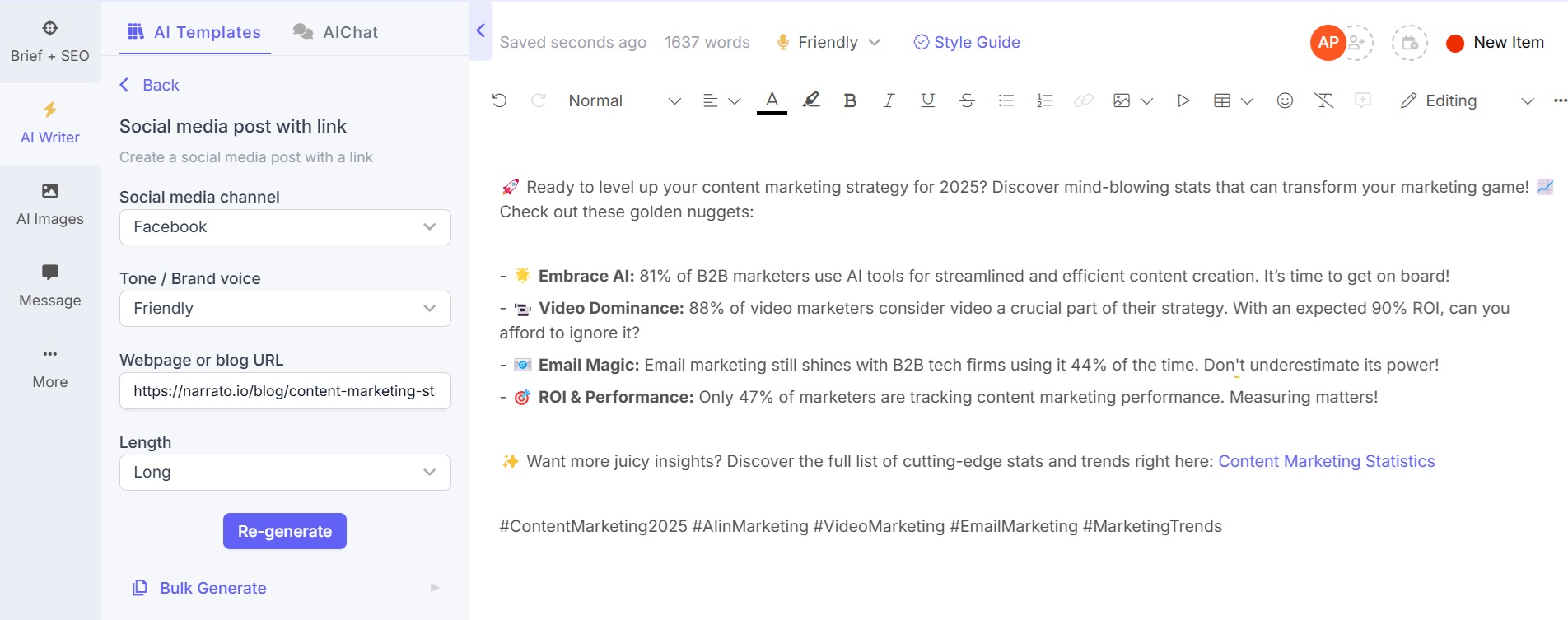
To create a post on tips from the article, you’ll need to use a template that requires you to provide the text based on which Narrato will compose a post. Simply paste the relevant information, making sure to include a CTA and the article link, and the AI will generate an engaging post that encourages clicks to the core article.
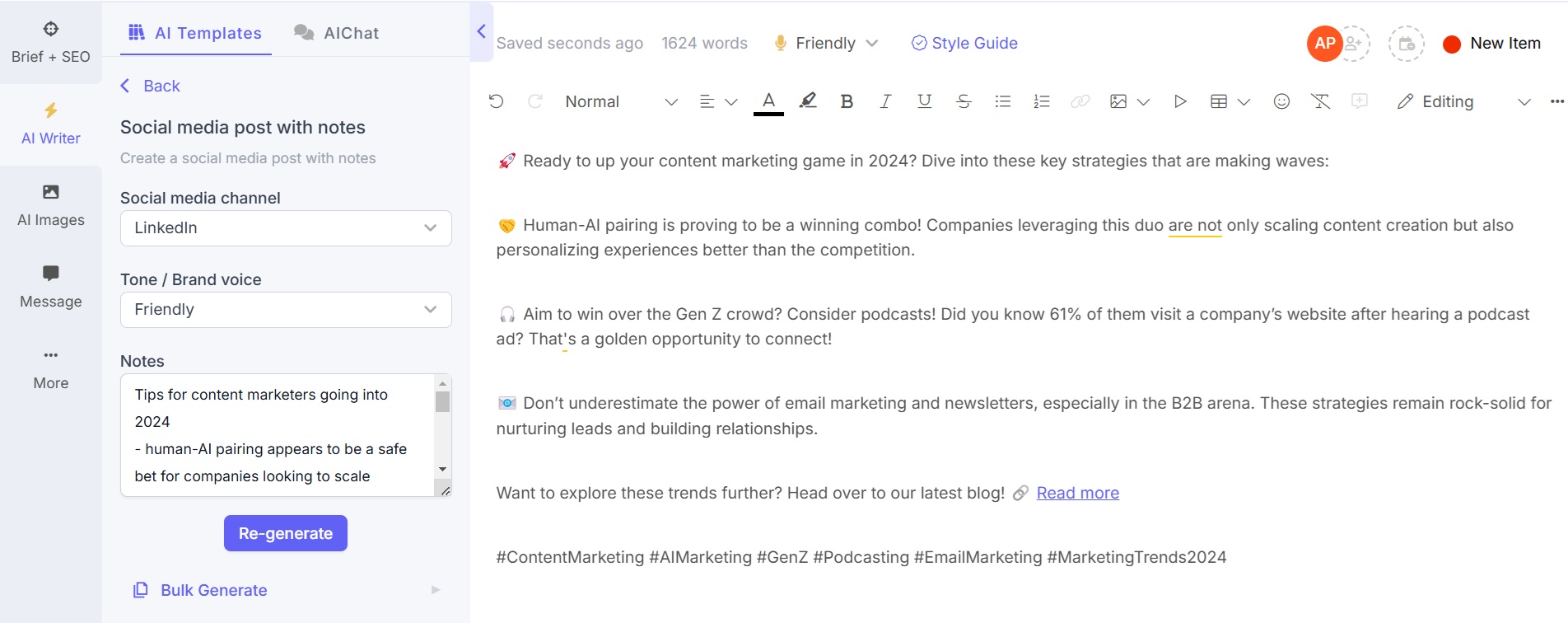
Once you’ve generated a couple of posts in your Narrato workspace, you can publish them or schedule for posting directly on the platform. Before that, connect your Facebook, Instagram, or LinkedIn account to Narrato.
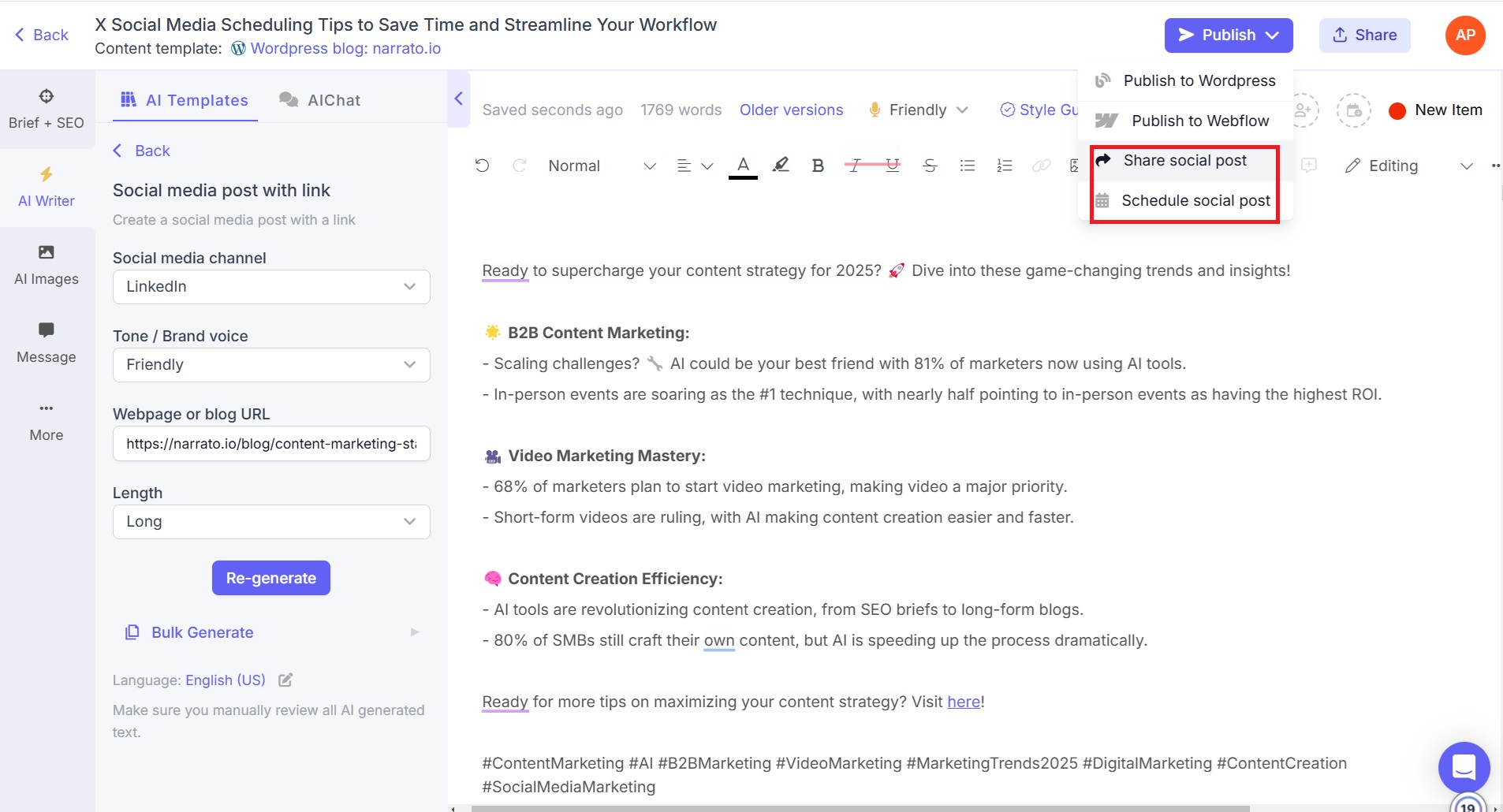
To schedule your post, select the relevant social media account, and the date and time for posting.
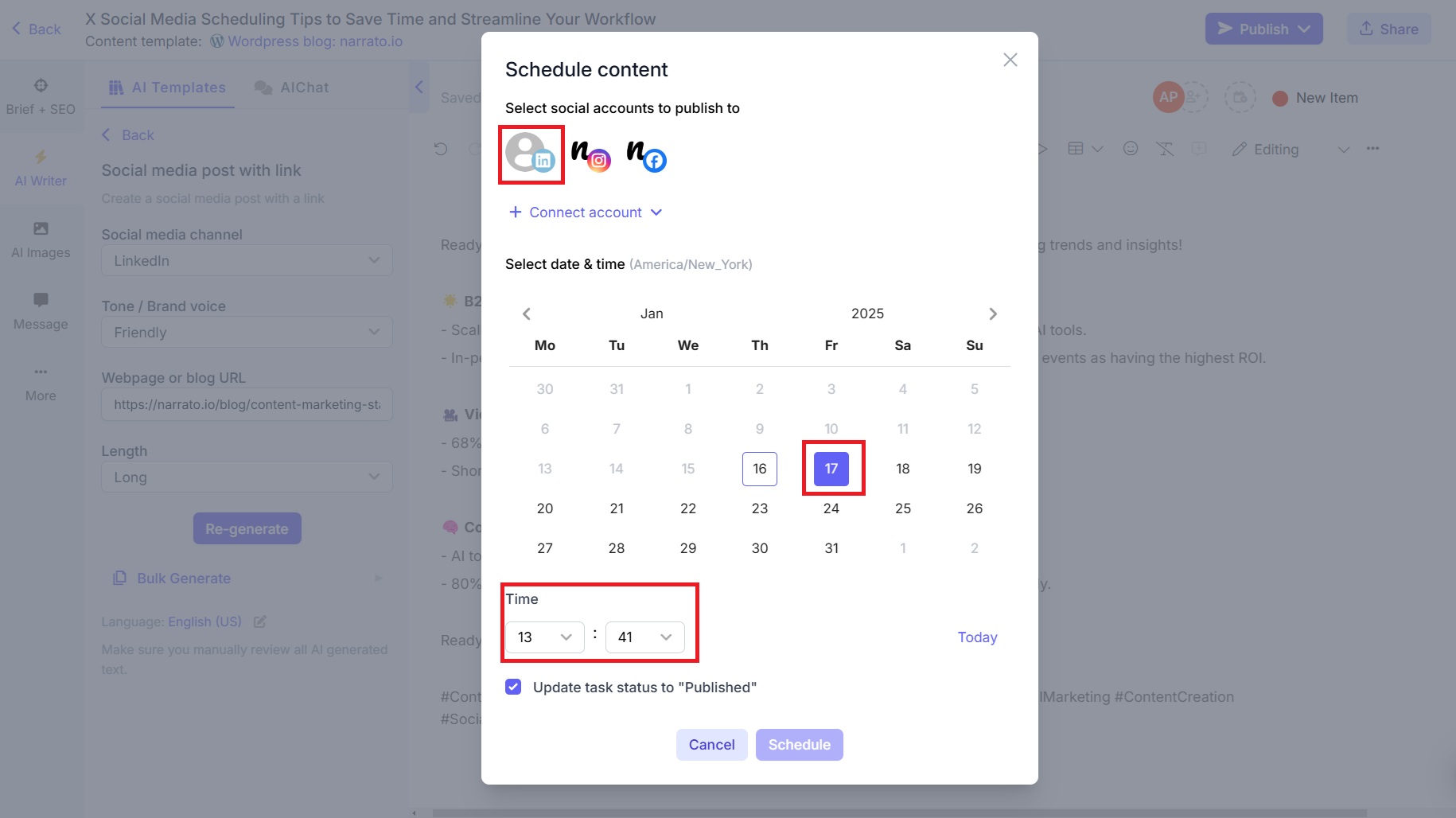
If your busy schedule leaves you little time to create social media content, Narrato’s Content Genie can lend you a helping hand. Genie generates engaging posts promoting your blog posts and special events and occasions, as you can see in the example below.
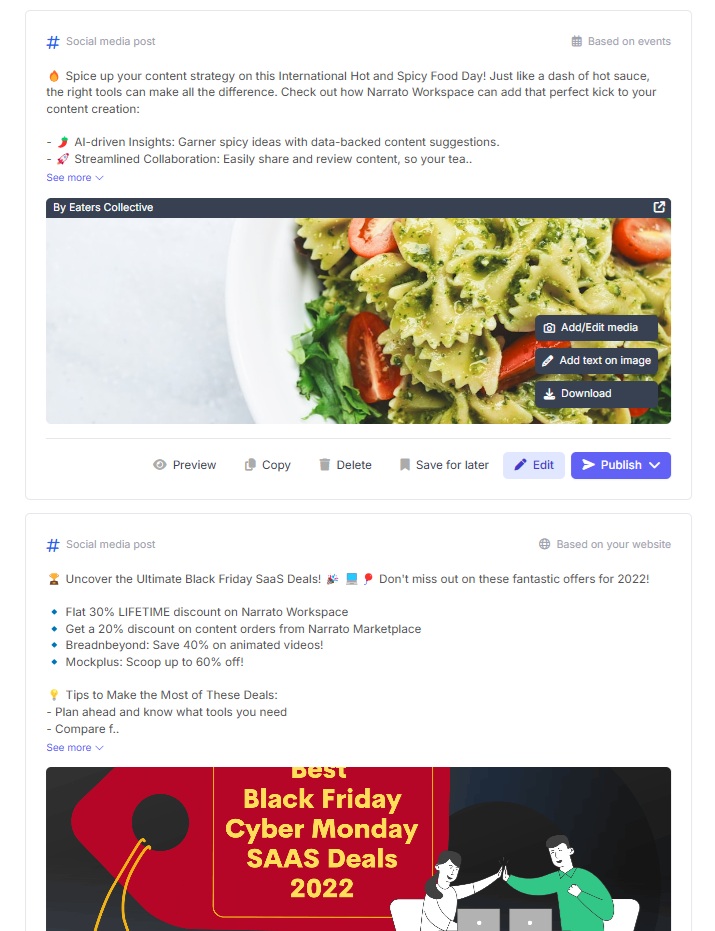
You can assign post checking and refinement to one or more members of your team, and assign due dates on the Narrato workspace. Collaborators on the Narrato workspace can edit posts, leave comments, and send messages to team members with @mentions. They can choose the appropriate project status (also visually indicated by colors), which helps in staying organized and scheduling resources as required.
Narrato integrates a social media calendar where you can add your weekly tasks and keep tabs on their status. You can download your monthly social media report for your records, strategy, and analytics.
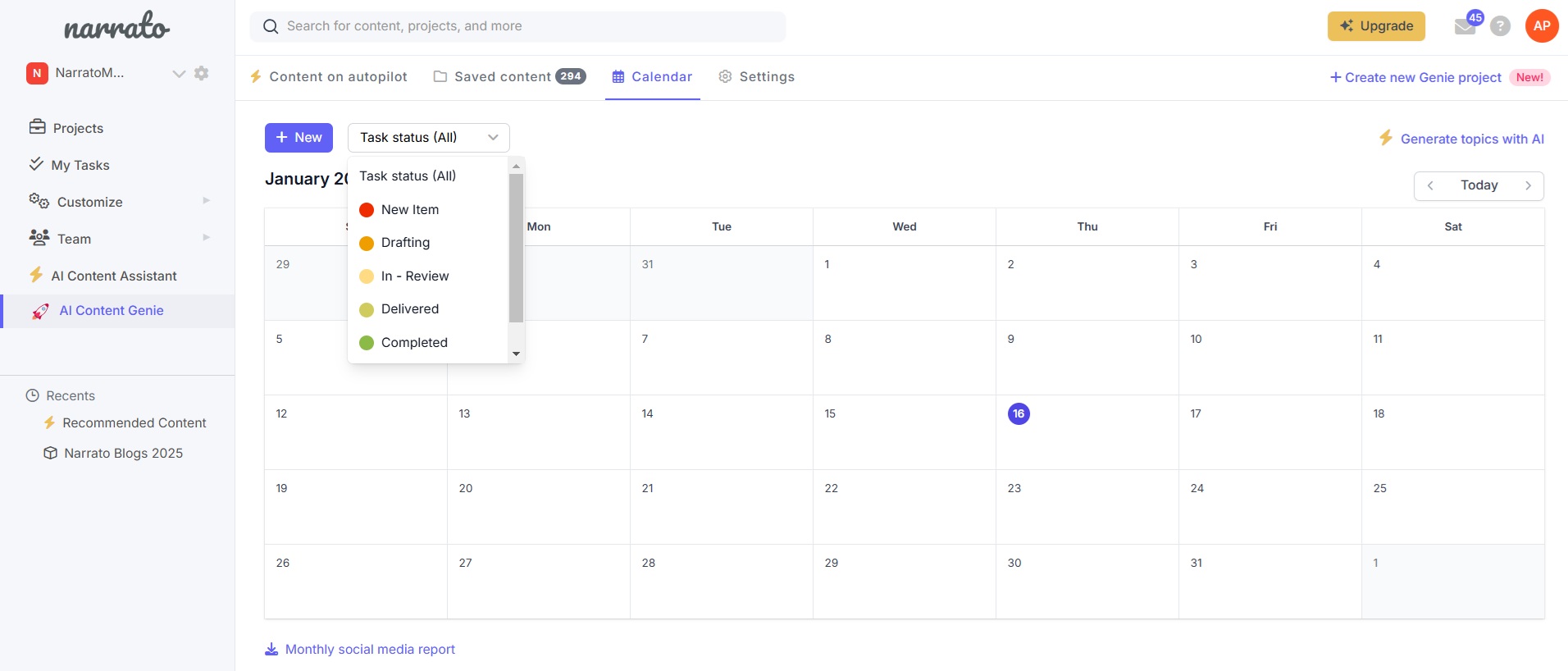
Great content, on time
Scheduling posts is a time-tested way to ensure a consistent social media presence. Social media scheduling tools powered by AI automate content generation, saving you more time for strategy and engagement. You’ll still need to monitor the content being generated, make improvements as needed, and check your calendar. But overall, letting AI do the heavy-lifting will only help your productivity. See how Narrato works in practice to understand the benefits you can accrue from it. Narrato is available on a 7-day free trial.


